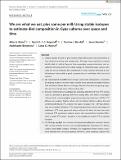| dc.contributor.author | Baino, Allan | |
| dc.contributor.author | Hopcraft, Grant | |
| dc.contributor.author | Kendall, Corinne | |
| dc.contributor.author | Newton, Jason | |
| dc.contributor.author | Behdenna, Abdelkader | |
| dc.contributor.author | Munishi, Linus | |
| dc.date.accessioned | 2022-04-05T09:59:29Z | |
| dc.date.available | 2022-04-05T09:59:29Z | |
| dc.date.issued | 2022-02 | |
| dc.identifier.uri | https://doi.org/10.1002/ece3.8726 | |
| dc.identifier.uri | https://dspace.nm-aist.ac.tz/handle/20.500.12479/1439 | |
| dc.description | This research article published by John Wiley & Sons, Ltd, 2022 | en_US |
| dc.description.abstract | 1. Dietary studies in birds of prey involve direct observation and examination of
food remains at resting and nesting sites. Although these methods accurately
identify diet in raptors, they are time-consuming, resource-intensive, and associated with biases from the feeding ecology of raptors like Gyps vultures. Our
study set out to estimate diet composition in Gyps vultures informed by stable isotopes that provide a good representation of assimilated diet from local
systems.
2. We hypothesized that differences in Gyps vulture diet composition is a function
of sampling location and that these vultures move between Serengeti National
Park and Selous Game Reserve to forage. We also theorized that grazing ungulates are the principal items in Gyps vulture diet.
3. Through combined linear and Bayesian modeling, diet derived from δ13C in Gyps
vultures consisted of grazing herbivores across sites, with those in Serengeti
National Park consuming higher proportions of grazing herbivores (>87%). δ13C
differences in vulture feather subsets did not indicate shifts in vulture diet and
combined with blood δ13C, vultures fed largely on grazers for ~159 days before
they were sampled. Similarly, δ15N values indicated Gyps vultures fed largely on
herbivores. δ34S ratios separated where vultures fed when the two sites were
compared. δ34S variation in vultures across sites resulted from baseline differences in plant δ34S values, though it is not possible to match δ34S to specific
locations.
4. Our findings highlight the relevance of repeated sampling that considers tissues
with varying isotopic turnover and emerging Bayesian techniques for dietary
studies using stable isotopes. Findings also suggested limited vulture movement between the two local systems. However, more sampling coupled with environmental data is required to fully comprehend this observation and its implication to Gyps vulture ecology and conservation. | en_US |
| dc.language.iso | en | en_US |
| dc.publisher | John Wiley & Sons, Ltd | en_US |
| dc.subject | African white-backed vulture | en_US |
| dc.subject | Diet composition | en_US |
| dc.subject | Rüppell's vulture | en_US |
| dc.subject | Stable isotopes | en_US |
| dc.subject | Trophic discrimination factors | en_US |
| dc.title | We are what we eat, plus some per mill: Using stable isotopes to estimate diet composition in Gyps vultures over space and time | en_US |
| dc.type | Article | en_US |

